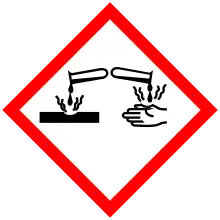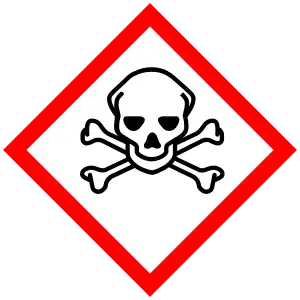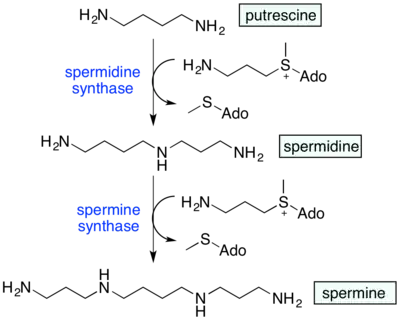Putrescine
Skeletal formula | |
 | |
| Names | |
|---|---|
| Preferred IUPAC name
Butane-1,4-diamine | |
| Other names
1,4-Diaminobutane, 1,4-Butanediamine | |
| Identifiers | |
CAS Number |
|
3D model (JSmol) |
|
| 3DMet | |
Beilstein Reference |
605282 |
| ChEBI | |
| ChEMBL | |
| ChemSpider | |
| DrugBank | |
| ECHA InfoCard | 100.003.440 |
| EC Number |
|
Gmelin Reference |
1715 |
| KEGG | |
| MeSH | Putrescine |
PubChem CID |
|
| RTECS number |
|
| UNII | |
| UN number | 2928 |
CompTox Dashboard (EPA) |
|
InChI
| |
SMILES
| |
| Properties | |
Chemical formula |
C4H12N2 |
| Molar mass | 88.154 g·mol−1 |
| Appearance | Colourless crystals |
| Odor | fishy-ammoniacal, pungent |
| Density | 0.877 g/mL |
| Melting point | 27.5 °C (81.5 °F; 300.6 K) |
| Boiling point | 158.6 °C; 317.4 °F; 431.7 K |
Solubility in water |
Miscible |
| log P | −0.466 |
| Vapor pressure | 2.33 mm Hg at 25 deg C (est) |
Henry's law constant (kH) |
3.54x10−10 atm-cu m/mol at 25 deg C (est) |
Refractive index (nD) |
1.457 |
| Hazards | |
| GHS labelling: | |
Pictograms |
   |
Signal word |
Danger |
Hazard statements |
H228, H302, H312, H314, H331 |
Precautionary statements |
P210, P261, P280, P305+P351+P338, P310 |
| Flash point | 51 °C (124 °F; 324 K) |
| Explosive limits | 0.98–9.08% |
| Lethal dose or concentration (LD, LC): | |
LD50 (median dose) |
|
| Related compounds | |
Related alkanamines |
|
Related compounds |
|
Except where otherwise noted, data are given for materials in their standard state (at 25 °C [77 °F], 100 kPa). | |
| Infobox references | |
Putrescine is an organic compound with the formula (CH2)4(NH2)2. It is a colorless solid that melts near room temperature. It is classified as a diamine.[3] Together with cadaverine, it is largely responsible for the foul odor of putrefying flesh, but also contributes to other unpleasant odors.
Production
Putrescine is produced on an industrial scale by the hydrogenation of succinonitrile.[3]
Biotechnological production of putrescine from renewable feedstock has been investigated. A metabolically engineered strain of Escherichia coli that produces putrescine at high titer in glucose mineral salts medium has been described.[4]
Biochemistry

Spermidine synthase uses putrescine and S-adenosylmethioninamine (decarboxylated S-adenosyl methionine) to produce spermidine. Spermidine in turn is combined with another S-adenosylmethioninamine and gets converted to spermine.
Putrescine is synthesized in small quantities by healthy living cells by the action of ornithine decarboxylase.
Putrescine is synthesized biologically via two different pathways, both starting from arginine.
- In one pathway, arginine is converted into agmatine. The conversion iiss catalyzed by the enzyme arginine decarboxylase (ADC). Agmatine is transformed into N-carbamoylputrescine by agmatine imino hydroxylase (AIH). Finally, N-carbamoylputrescine is hydrolyzed to give putrescine.[5]
- In the second pathway, arginine is converted into ornithine and then ornithine is converted into putrescine by ornithine decarboxylase (ODC).
Occurrence
Putrescine is a component of bad breath and bacterial vaginosis.[6] It is also found in semen and some microalgae, together with spermine and spermidine. It is one of the simplest, appear to be factors necessary for proper eukaryotic cell division.
Uses
It reacts with adipic acid to yield the polyamide Nylon 46, which is marketed by DSM under the trade name Stanyl.[7]
Application of putrescine, along with other polyamines, can be used to extend the shelf life of fruits by delaying the ripening process.[8] Pre-harvest application of putrescine has been shown to increase plant resistance to high temperatures and drought.[9] Both of these effects seem to result from lowered ethylene production following exogenous putrescine exposure.[10]
Due to its role in putrification, putrescine has also been proposed as a biochemical marker for determining how long a corpse has been decomposing.[11]
History
Putrescine and cadaverine were first described in 1885 by the Berlin physician Ludwig Brieger (1849–1919).[12][13][14]
Toxicity
In rats it has a low acute oral toxicity of 2000 mg/kg body weight, with no-observed-adverse-effect level of 2000 ppm (180 mg/kg body weight/day).[15]
Further reading
- Haglund, William (1996). Forensic taphonomy: The Postmortem Fate of Human Remains. CRC Press. pp. 100. ISBN 0-8493-9434-1.
References
- ↑ "CSD Entry: QATWAJ : 1,4-Butanediamine". Cambridge Structural Database: Access Structures. Cambridge Crystallographic Data Centre. doi:10.5517/cc4g850. Retrieved 2021-11-07.
- ↑ Thalladi, V. R.; Boese, R.; Weiss, H.-C. (2000). "The Melting Point Alternation in α,ω-Alkanediols and α,ω-Alkanediamines: Interplay between Hydrogen Bonding and Hydrophobic Interactions". Angew. Chem. Int. Ed. 39 (5): 918–922. doi:10.1002/(SICI)1521-3773(20000303)39:5<918::AID-ANIE918>3.0.CO;2-E.
- 1 2 Eller, Karsten; Henkes, Erhard; Rossbacher, Roland; Höke, Hartmut (2000). "Amines, Aliphatic". Ullmann's Encyclopedia of Industrial Chemistry. Weinheim: Wiley-VCH. doi:10.1002/14356007.a02_001.
- ↑ Qian, Zhi-Gang; Xia, Xiao-Xia; Yup Lee, Sang (2009). "Metabolic Engineering of Escherichia coli for the Production of Putrescine: A Four Carbon Diamine". Biotechnology and Bioengineering. 104 (4): 651–662. doi:10.1002/bit.22502. PMID 19714672.
- ↑ Srivenugopal KS, Adiga PR (September 1981). "Enzymic conversion of agmatine to putrescine in Lathyrus sativus seedlings. Purification and properties of a multifunctional enzyme (putrescine synthase)". J. Biol. Chem. 256 (18): 9532–41. doi:10.1016/S0021-9258(19)68795-8. PMID 6895223.
- ↑ Yeoman, CJ;Thomas, SM; Miller, ME; Ulanov, AV; Torralba, M; Lucas, S; Gillis, M; Cregger, M; Gomez, A; Ho, M; Leigh, SR; Stumpf, R; Creedon, DJ; Smith, MA; Weisbaum, JS; Nelson, KE; Wilson, BA; White, BA (2013). "A multi-omic systems-based approach reveals metabolic markers of bacterial vaginosis and insight into the disease". PLOS ONE. 8 (2): e56111. Bibcode:2013PLoSO...856111Y. doi:10.1371/journal.pone.0056111. PMC 3566083. PMID 23405259.
{{cite journal}}: CS1 maint: uses authors parameter (link) - ↑ "Electronic Control Modules (ECU) - Electrical & Electronics - Applications - DSM". Dsm.com. Retrieved 18 December 2015.
- ↑ Abbasi, Nadeem Akhtar; Ali, Irfan; Hafiz, Ishfaq Ahmad; Alenazi, Mekhled M.; Shafiq, Muhammad (January 2019). "Effects of Putrescine Application on Peach Fruit during Storage". Sustainability. 11 (7): 2013. doi:10.3390/su11072013.
- ↑ Todorov, D.; Alexieva, V.; Karanov, E. (1998-12-01). "Effect of Putrescine, 4-PU-30, and Abscisic Acid on Maize Plants Grown under Normal, Drought, and Rewatering Conditions". Journal of Plant Growth Regulation. 17 (4): 197–203. doi:10.1007/PL00007035. ISSN 1435-8107. PMID 9892742. S2CID 20062811.
- ↑ Khan, A.S.; Z. Singh (May 2008). "Influence of Pre and Postharvest Applications of Putrescine on Ethylene Production, Storage Life and Quality of 'Angelino' Plum". Acta Horticulturae (768): 125–133. doi:10.17660/ActaHortic.2008.768.14. ISSN 0567-7572.
- ↑ Pelletti, Guido; Garagnani, Marco; Barone, Rossella; Boscolo-Berto, Rafael; Rossi, Francesca; Morotti, Annalisa; Roffi, Raffaella; Fais, Paolo; Pelotti, Susi (2019-04-01). "Validation and preliminary application of a GC–MS method for the determination of putrescine and cadaverine in the human brain: a promising technique for PMI estimation". Forensic Science International. 297: 221–227. doi:10.1016/j.forsciint.2019.01.025. ISSN 0379-0738. PMID 30831414. S2CID 73461335.
- ↑ Brief biography of Ludwig Brieger Archived 2011-10-03 at the Wayback Machine (in German). Biography of Ludwig Brieger in English.
- ↑ Ludwig Brieger, "Weitere Untersuchungen über Ptomaine" [Further investigations into ptomaines] (Berlin, Germany: August Hirschwald, 1885), page 43. From page 43: Ich nenne dasselbe Putrescin, von putresco, faul werden, vermodern, verwesen. (I call this [compound] "putrescine", from [the Latin word] putresco, to become rotten, decay, rot.)
- ↑ Ludwig Brieger, "Weitere Untersuchungen über Ptomaine" [Further investigations into ptomaines] (Berlin, Germany: August Hirschwald, 1885), page 39.
- ↑ Til, H.P.; Falke, H.E.; Prinsen, M.K.; Willems, M.I. (1997). "Acute and subacute toxicity of tyramine, spermidine, spermine, putrescine and cadaverine in rats". Food and Chemical Toxicology. 35 (3–4): 337–348. doi:10.1016/S0278-6915(97)00121-X. ISSN 0278-6915. PMID 9207896.